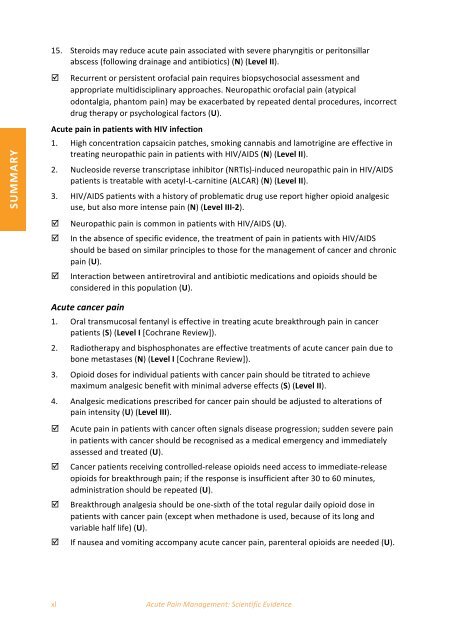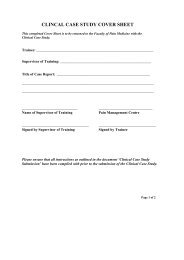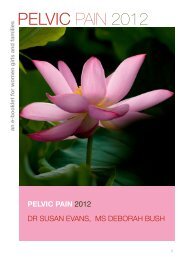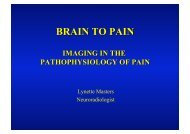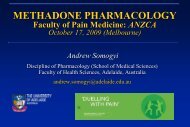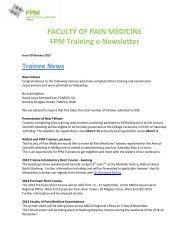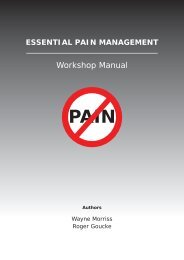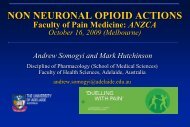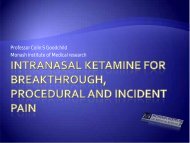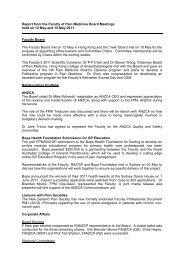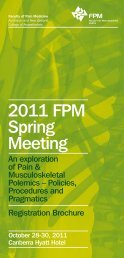Acute Pain - final version - Faculty of pain medicine - Australian and ...
Acute Pain - final version - Faculty of pain medicine - Australian and ...
Acute Pain - final version - Faculty of pain medicine - Australian and ...
Create successful ePaper yourself
Turn your PDF publications into a flip-book with our unique Google optimized e-Paper software.
<br />
<br />
15. Steroids may reduce acute <strong>pain</strong> associated with severe pharyngitis or peritonsillar <br />
abscess (following drainage <strong>and</strong> antibiotics) (N) (Level II). <br />
SUMMARY <br />
<br />
Recurrent or persistent or<strong>of</strong>acial <strong>pain</strong> requires biopsychosocial assessment <strong>and</strong> <br />
appropriate multidisciplinary approaches. Neuropathic or<strong>of</strong>acial <strong>pain</strong> (atypical <br />
odontalgia, phantom <strong>pain</strong>) may be exacerbated by repeated dental procedures, incorrect <br />
drug therapy or psychological factors (U). <br />
<strong>Acute</strong> <strong>pain</strong> in patients with HIV infection <br />
1. High concentration capsaicin patches, smoking cannabis <strong>and</strong> lamotrigine are effective in <br />
treating neuropathic <strong>pain</strong> in patients with HIV/AIDS (N) (Level II). <br />
2. Nucleoside reverse transcriptase inhibitor (NRTIs)‐induced neuropathic <strong>pain</strong> in HIV/AIDS <br />
patients is treatable with acetyl‐L‐carnitine (ALCAR) (N) (Level II). <br />
3. HIV/AIDS patients with a history <strong>of</strong> problematic drug use report higher opioid analgesic <br />
use, but also more intense <strong>pain</strong> (N) (Level III‐2). <br />
<br />
<br />
<br />
Neuropathic <strong>pain</strong> is common in patients with HIV/AIDS (U). <br />
In the absence <strong>of</strong> specific evidence, the treatment <strong>of</strong> <strong>pain</strong> in patients with HIV/AIDS <br />
should be based on similar principles to those for the management <strong>of</strong> cancer <strong>and</strong> chronic <br />
<strong>pain</strong> (U). <br />
Interaction between antiretroviral <strong>and</strong> antibiotic medications <strong>and</strong> opioids should be <br />
considered in this population (U). <br />
<strong>Acute</strong> cancer <strong>pain</strong> <br />
1. Oral transmucosal fentanyl is effective in treating acute breakthrough <strong>pain</strong> in cancer <br />
patients (S) (Level I [Cochrane Review]). <br />
2. Radiotherapy <strong>and</strong> bisphosphonates are effective treatments <strong>of</strong> acute cancer <strong>pain</strong> due to <br />
bone metastases (N) (Level I [Cochrane Review]). <br />
3. Opioid doses for individual patients with cancer <strong>pain</strong> should be titrated to achieve <br />
maximum analgesic benefit with minimal adverse effects (S) (Level II). <br />
4. Analgesic medications prescribed for cancer <strong>pain</strong> should be adjusted to alterations <strong>of</strong> <br />
<strong>pain</strong> intensity (U) (Level III). <br />
<br />
<br />
<br />
<br />
<strong>Acute</strong> <strong>pain</strong> in patients with cancer <strong>of</strong>ten signals disease progression; sudden severe <strong>pain</strong> <br />
in patients with cancer should be recognised as a medical emergency <strong>and</strong> immediately <br />
assessed <strong>and</strong> treated (U). <br />
Cancer patients receiving controlled‐release opioids need access to immediate‐release <br />
opioids for breakthrough <strong>pain</strong>; if the response is insufficient after 30 to 60 minutes, <br />
administration should be repeated (U). <br />
Breakthrough analgesia should be one‐sixth <strong>of</strong> the total regular daily opioid dose in <br />
patients with cancer <strong>pain</strong> (except when methadone is used, because <strong>of</strong> its long <strong>and</strong> <br />
variable half life) (U). <br />
If nausea <strong>and</strong> vomiting accompany acute cancer <strong>pain</strong>, parenteral opioids are needed (U). <br />
xl <br />
<strong>Acute</strong> <strong>Pain</strong> Management: Scientific Evidence


